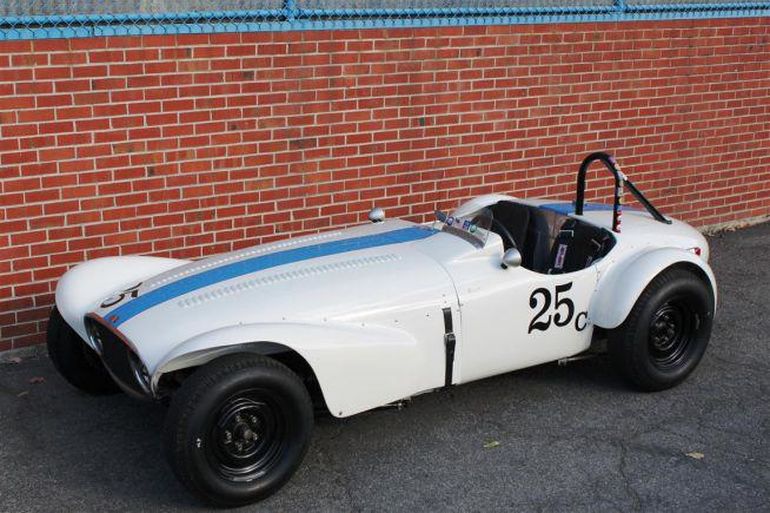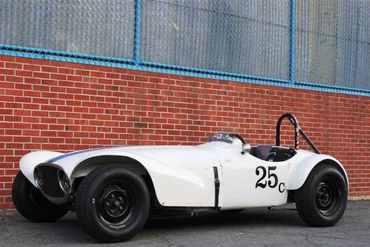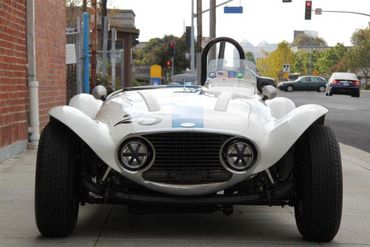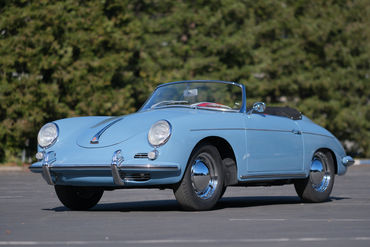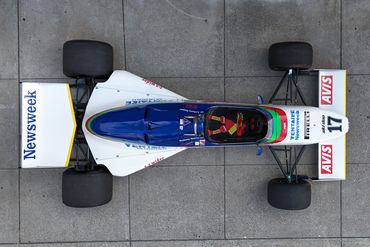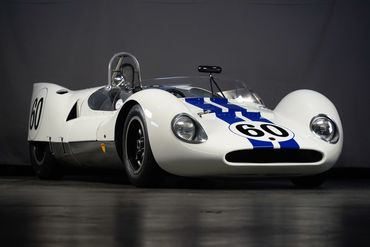Sold
SOLD 08/12
1953 Tatum
Special
Magnificent American Road Racing Special. Period and Historic West Coast Racing History.
- VIN001
- Exterior ColorWhite with Blue Stripe
- Interior ColorBlack
- Mileage12 Miles
- Engine302 c.i. GMC Engine
- Engine no.30200685
- Transmission4-Speed
- StatusSold
- StockFJ1170
Description
1953 Tatum Wayne GMC Special
s/n DRF54952
White with Blue Stripe
In 1952, Check Tatum attended a Sports Car Race in his home town of Stockton, California. That evening in the bar of the local hotel, Chuck and three of his friends, Sam Weiss, Phil Hill and Doug Trotter, were discussing the merits of the cars they saw racing earlier that day and it was noted that the front running cars were “foreign” cars imported from Europe. At one point in this discussion, Chuck made a statement to the effect that he could probably build a car out of American parts that would beat all of that “foreign” stuff. He considered the Allard, which was one of the fastest cars at the races, to be nothing but a big American hot rod in English disguise. The next day, Chuck discussed with Doug Trotter some of the ideas he had on how to build a winning all American road race car. Chuck was young and energetic but had several years of experience with both building and driving stock cars, sprint cars and track roadsters and his ideas for a road race car incorporated features from these types of cars.
Over the winter of 1952-53, construction on the car was started in the shop behind Chuck Tatum’s house. A light but very rigid frame was assembled using thin wall 2 inch diameter seamless tubing. Front suspension was taken from a ’32 Ford, spindles were ’39 Ford. Steering was ’40 Ford with a custom extra long pitman arm to “sharpen the steering”. The rear suspension was ’41 Ford pick-up initially with leaf springs. During the construction, Chuck designed a coil spring suspension with bars to locate the position of the rear axle. For an engine, Chuck considered several options before choosing the six cylinder 270 cubic inch GMC Truck engine. This engine was very strong and when bored out would result in a displacement of 302 cubic inches. The GMC engine was 25 pounds lighter and more reliable than a Ford “Flat Head” V-8, and 200-300 pounds lighter than a Cadillac, or Chrysler engine. GMC engines were being used in sprint cars and some “Speed Equipment” was available. A Mallory distributor was used for the ignition and Chuck designed a special intake manifold to mount three side draft Carter carburetors from a 1953 Corvette. The transmission was from a Lincoln Zephyr, and the brakes were Kinmont “disc” brakes. Both the transmission and brakes proved to be less than satisfactory and were later changed.
The finished chassis was taken to Jack Hagemann of San Leandro, California, for the construction of the aluminum body work. Jack usually designed the bodies he built and didn’t care much for the shape of this body, which was designed by Chuck Tatum’s friend Arden Farey, but he agreed to take on the job anyway. When jack was finished with a body, he would attach a small badge with the inscription “Designed by & Built by Jack Hagemann”. For the Tatum, he made a special badge which only read “Built by Jack Hagemann”. The original design incorporated the use of “cycle” type fenders but after several failures of the attaching brackets which resulted in the fenders falling off and being run over, the car was returned to jack Hagemann for the construction and installation of more conventional fenders.
The “Tatum” was finished in the spring of 1953 and was entered in its first race at Golden Gate Park in San Francisco, California. At the time, the Sports Car Club of America was strictly an amateur organization and didn’t allow “professional” drivers. Chuck Tatum had been driving sprint cars professionally and didn’t qualify as an “amateur”, so he asked his friend Chuck Manning to drive the “Tatum Special” in its first race. The car was an immediate success with Chuck Manning driving the car to a First Place finish. The car went on to finish First at Madera, Stockton, and Santa Barbara in the 1953 season.
The opportunity that Chuck Tatum had to drive as an amateur was at a race in his home town of Stockton. He won the race after starting in 33rd position with Cadillac powered Allard’s in the front rows. At the races that day, a very proper English lady was examining the cars in the pits. While she was looking at the open engine compartment of the Tatum, she inquired “I say, is this that beastly car with a lorry engine in it?” After that, the pit crew referred to the “Tatum Special” as “The Beast”.
During the three years that Chuck raced the car, he competed at most of the major races on the west coast such as Pebble Beach, Palm Springs, Torre Pines, Willow Springs, March Field, Buchanan Field, Golden Gate Park, Madera, Stockton, and Santa Barbara.
With his success in 1953, Chuck Tatum was able to secure sponsorship for an engine from Wayne Engineering, manufacturers of speed equipment for six cylinder Chevrolet and GMC engines. For the 1954 season, Wayne sent Chuck a new GMC engine fitted with their famous Wayne 12-Port Cross Flow cylinder head. The ignition system was still Mallory, but the carburetion was changed to three Zenith 2-throat side draft carburetors from a GMC fire truck. The new engine produced considerably more power than the 1953 engine that used a modified truck cylinder head. Chuck took the car to the Bonneville Salt Flats where he drove the car to a top speed of 157 mph. At the end of the 1954 season, the Wayne Engine was sent back to the Wayne Factory for overhaul. When the engine was returned to Chuck in early 1955, the Zenith carburetors had been replaced with Weber Side Draft carburetors. During the 1955 season, while the car was being worked on in a Palo Alto garage, the Wayne engine was stolen and never recovered. Chuck finished the rest of the ’55 season with a borrowed Ford “Flat Head” V-8 engine.
Hot Rod Magazine chose the “Tatum Special” for its feature car for the October 1953 issue. Hot Rod Magazine usually featured Hot Rods, Drag Race cars, or cars that ran on the dry lakes and usually didn’t get involved with Sports Car Racing. The Tatum however was a different type of car. It was a hot rod that just happened to race in Sports Car events. The “Tatum Special” was featured on the cover of the magazine with a four page article inside.
At the Santa Barbara Road Races in 1953, several movie people from Hollywood were in attendance and were looking for some unique sports cars to use in an upcoming production. They wanted to rent the Tatum but Chuck said the only way they could use the car is if he did the driving. Chuck was made a member of the Screen Actors Guild and drove the car in the movie “Johnny Dark” staring Tony Curtis and Piper Laurie. Chuck went on to do more work in the movie industry.
In 1954, Chuck entered the “Tatum Special” in the National Roadster Show at Oakland, California. The car was quite a hit at the shop and won First Place for Best Sports Car.
In 1956, Chuck went to work for a Stockton car dealer as a manager of his sports car operation. His boss was easy to work for but had one hard and fast rule, “his managers could not compete in car racing”. Chuck could no longer race so the “Tatum” was put up for sale. In the next few years, several different engines were installed in the car by several different owners. As Chuck said, “Some of the owners didn’t treat the car with much respect”. After a while, Chuck lost track of the car and assumed it had been scrapped.
In the mid 1980’s, acting on a tip from a friend of his son Chuck Jr., Chuck tracked down the remains of the “Tatum Special” in a small junk yard just a few miles from his Stockton home. The engine and transmission were missing along with a lot of small pieces, but most of the original body work was still there as well as the frame, suspension, and dash. The “Tatum Special” was purchased and with the help of Chuck Jr. and his other son Blake, the car was restored, prepared for competition, and entered in vintage race events. When Chuck restored the car, he used a GMC engine with a production truck cylinder head as was originally used in 1953. Chuck wanted to use a Wayne Engine but very few of the special Wayne 12-port cylinder heads for the GMC engines were manufactured and Wayne engine components are very hard to find.
In 1966 the “Tatum Special” was purchased by Chris Wickersham of Pasadena, California. Chris has a small collection of vintage race cars and had admired the Tatum for several years prior to purchasing it. The car was then restored to the configuration that it was raced in 1955 with much attention paid to details. Chris, like Chuck Tatum, felt that the car should be fitted with a Wayne engine so, after six years of effort and several setbacks, in the spring of 2002 a Wayne engine was finally completed and installed in the Tatum. During the early years, Chuck Tatum painted the car several different colors, the last of which was white with a blue stripe. The car was refinished using this color combination and on the driver’s side you will even find a small badge with the words inscribed “Built by Jack Hagemann”.
Included with the Tatum Special are the following:
• Current Log Books
• Tatum “history” book – Includes copies of original pictures of construction, early racing, events, newspaper and magazine articles, printed material, magazines and misc. materials pertaining to the original and current history of the Tatum Special.
• Personal File – Personal notes and information relating to the building of the GMC/Wayne engine, chassis restoration, brake development, rear axle re-construction using modern day “Push-In” axles and “locker” type differential, etc.
• Spare Parts Inventory
The following is just a portion of the spare parts that are included with the sale of the Tatum Special:
• Extra set of wheels mounted with Dunlop Race Tyres
• Set of Cadillac hub caps for show
• Major engine components to construct a second GMC/Wayne engine:
GMC 302 ci “Military” Block
GMC Crank, Rocker Arms, and Misc. Engine Parts
Weber Carburetors, new in boxes
Wayne Head Casting, New (finish machining required)
Wayne Valve and Side Cover
Wayne Intake Adaptors for Weber Carburetors
• Ignition Tune-up Parts
• Brake Shoes
• Misc. Spares for the races
• Front Axle Assembly with Radius Rods, used
• Body Fixtures to mount the hood, mid-section and rear of the body when removed from the car
• Also included are the spare parts received when the car was purchased in 1996 which include:
Axle Shafts, Brake Drums, Backing Plates, Fuel Tank, Misc. Engine Parts and lots of misc. stuff
[Please note – all spare parts are FOB West Covina (Southern California)]
More to come…..
The above vehicle information is complete and accurate to the best of our knowledge at the time it is posted to this website. Corrections or additional information is always appreciated. All advertised prices exclude government fees and taxes, any finance charges, any dealer document preparation charge, and any emission testing charge. Vehicles are subject to prior sale. All advertised to be true but not guaranteed. We assume no liability for errors or omissions.
Inquire About This Car
Fantasy Junction • 510-653-7555 • 1145 Park Ave, Emeryville, CA 94608
